 Technology peripherals
Technology peripherals
 AI
AI
 Detailed explanation of commonly used control methods for smart car planning and control
Detailed explanation of commonly used control methods for smart car planning and control
Detailed explanation of commonly used control methods for smart car planning and control
Control is the strategy that drives the vehicle forward. The goal of control is to use feasible control quantities to minimize the deviation from the target trajectory, maximize passenger comfort, etc.

As shown in the figure above, the modules associated with the input of the control module include planning module, positioning module and vehicle information, etc. The positioning module provides vehicle location information, the planning module provides target trajectory information, and vehicle information includes gear, speed, acceleration, etc. The control outputs are steering, acceleration and braking quantities.
The control module is mainly divided into horizontal control and vertical control. According to the different coupling forms, it can be divided into two methods: independent and integrated.
1 Control method
1.1 Decoupling control
So-called Decoupled control means to control horizontal and vertical control methods independently.
1.2 Coupling control
Coupling control takes into account the coupling problems that exist in horizontal and vertical control. A typical example is that a car cannot corner at high speed because when the longitudinal speed is too high, the lateral angular speed needs to be limited, otherwise the centripetal force cannot satisfy the centripetal acceleration.

The typical representative method of horizontal and vertical integration is linear time-varying model predictive control. This method adds horizontal and vertical integration on the basis of model predictive control. constraint. Such as maximum centripetal acceleration constraints, etc.
1.3 Lateral control

##As shown above, lateral control can be divided into geometric methods and kinematic model-based methods. methods and dynamic model-based methods.
1.3.1 Feedforward control
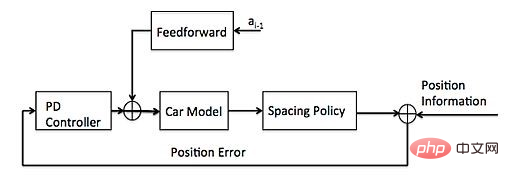
The so-called feedforward control is based on tracking point information. Control the amount to make appropriate compensation in advance. A typical example is to use the curvature information in the tracking sequence points to compensate for the rotation angle.
1.3.2 Chained Form
The chained system linearizes the nonlinear system into multiple layers, and decomposes the system layer by layer. In turn, the system can be slowed down, similar to the filtering system [3].

System model in frenet coordinates:

 ##1.3.3 Lyapunov
##1.3.3 Lyapunov
Based on Lyapunov The design of Nove stability method can be applied to kinematic and dynamic models. The basic idea is to first establish a kinematic or dynamic model, propose a tracking method based on the model, and then establish a Lyapunov function to prove the asymptotic stability of the closed-loop system through Lyapunov stability [4].
- Kinematic model
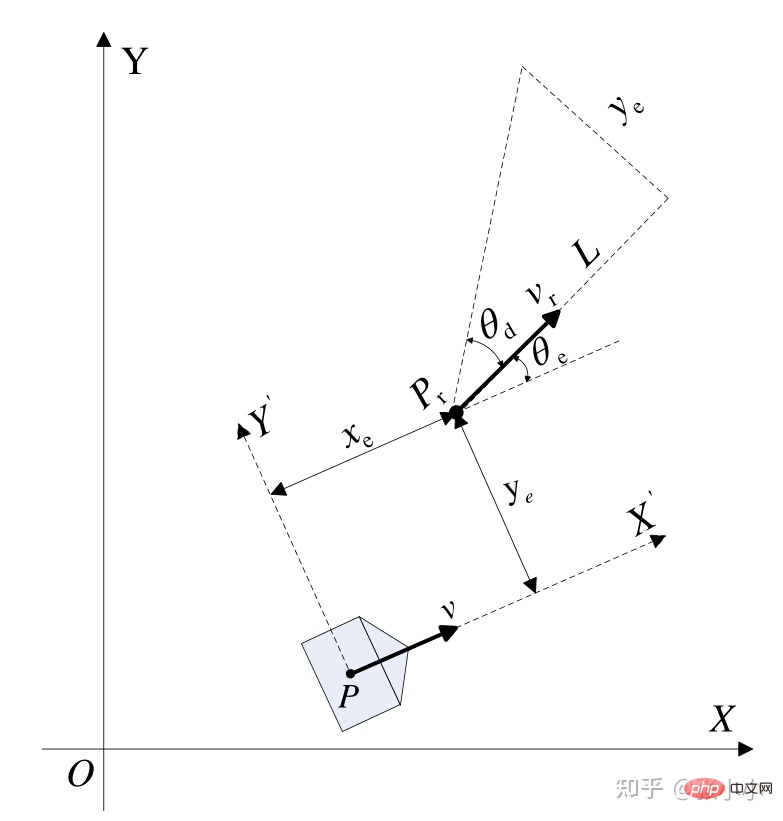
As shown in the figure above, the current point of the car is P, tracking the target point For Pr. is the pose difference between the current position and the target point, and are the reference velocity and angular velocity respectively. Design Lyapunov function:

Tracking rate design:

Finally, by limiting the constraint design parameters, the asymptotic stability of the tracking rate is proved, that is, when → ∞, → 0.
- Kinematic model
First establish the kinetic model:
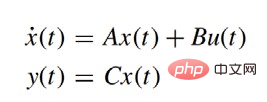
Among them:

order

The error is:

Design cost function:

Design control rate:

Finally proves asymptotic stability.
1.3.4 Pure Pursuit
Pure tracking is a geometric path tracking controller. This controller uses the geometric relationship between the vehicle motion and the reference path to track the controller of the reference path. This control method uses the center of the vehicle's rear axle as a reference point.

According to the above picture, you can push out the front wheel turning command:

where R is the turning radius, L is the vehicle wheelbase, e is the lateral error between the vehicle's current attitude and the target waypoint, is the forward-looking distance and .

According to the experimental data in the figure above, as the forward-looking distance increases, the tracking jitter becomes smaller and smaller. Shorter front-sight distance provides more accurate tracking, while longer front-sight distance provides smoother tracking. Another characteristic of the PurePursuit is that excessive front sight distance can cause "cutting corners" when tracking turns. The Pure Pursuit is a hard trade-off between stability and tracking performance.
1.3.5 Stanley
Different from the pure chasing pure tracking method where the rear axis is the reference point, the Stanley controller uses the front axis as the reference point. It takes into account both heading and lateral errors. The Stanley controller not only considers heading errors but also lateral errors.

According to the above picture, you can push out the front wheel turning command:

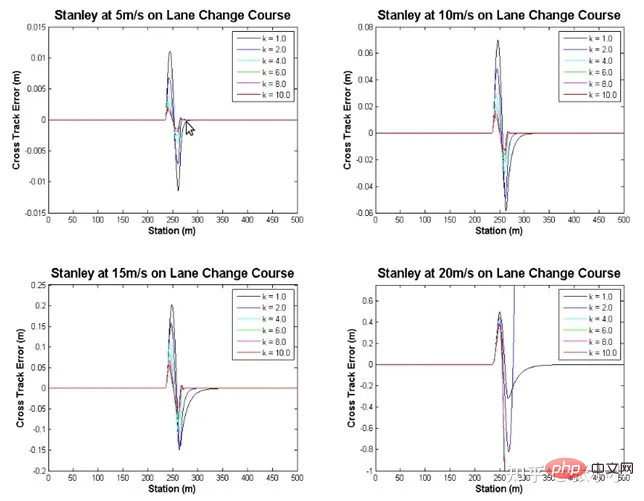
According to the experimental data in the above figure, as k increases, the tracking performance will also improve. Stanley does not have enough stability like Pure Pursuit when the vehicle speed increases.
1.3.6 LQR
The method based on the vehicle kinematic model ignores the dynamic characteristics of the vehicle, so when the vehicle speed is too fast or the curvature When the change rate is too large, the algorithm cannot meet the vehicle's stability control requirements. For control methods based on vehicle dynamics models, the primary task is to model vehicle dynamics. Since the accurate two-degree-of-freedom dynamic model is nonlinear, in order to facilitate real-time tracking control calculations, it is usually necessary to make some simplified approximations based on the accurate two-degree-of-freedom dynamic model to obtain a linear two-degree-of-freedom dynamic model.
- Vehicle two-degree-of-freedom dynamic model:


- LQR:
The Linear Quadratic Regulator (LQR) is a model-based controller that uses the state of the vehicle to minimize the error. LQR theory is the earliest and most mature state space design method in modern control theory. LQR can obtain the optimal control law of state linear feedback and is easy to form closed-loop optimal control.
LQR optimal design means that the designed state feedback controller K should minimize the quadratic objective function J, and K is uniquely determined by the weight matrices Q and R, so The choice of Q and R is particularly important. The following formula is the LQR cost function:

According to the vehicle dynamics model and the LQR cost function, the algebraic Licati equation can be derived:

Finally, the feedback matrix is calculated by iterating the Ricati equation, and then the optimal control amount is obtained based on the feedback matrix.
1.3.7 MPC
MPC (Model Prediction Control) is a method dedicated to extending the span of time, even to infinite time. The optimal control problem is decomposed into several optimization control problems with shorter time spans or limited time spans, and the optimal solution is still pursued to a certain extent.
MPC consists of the following three elements:
- Prediction model: The prediction model can predict changes in system status very well in a short period of time;
- Online rolling optimization: The results obtained by the prediction model There is still a deviation from the actual situation, so rolling optimization is used to find the local optimal solution at each moment. Usually, an objective (loss) function is designed and converted into a quadratic programming problem to find the optimal solution;
- Feedback Correction: Re-predict and optimize based on the new state at the next point in time.
- Prediction model:
The prediction model can be derived based on the vehicle dynamics model in LQR.
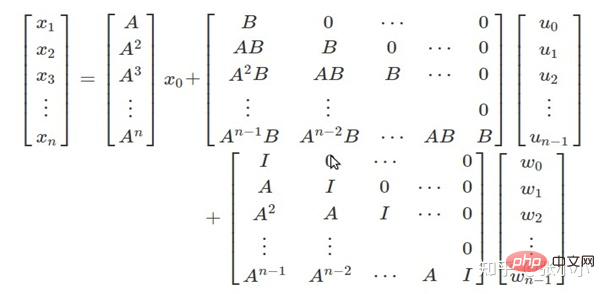
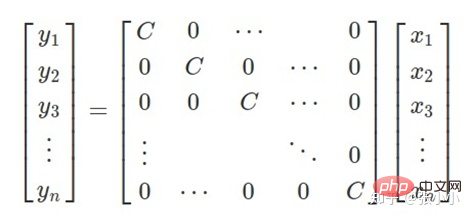
- Scroll optimization:
MPC cost function:

The corresponding control instructions can be obtained by optimizing the solution based on the prediction model, vehicle lateral constraints, and cost function.
1.3.8 Comparison of horizontal control algorithms

1.4 Vertical direction

As shown in the figure above, vertical control generally adopts the cascade pid control method.
2 Detailed design
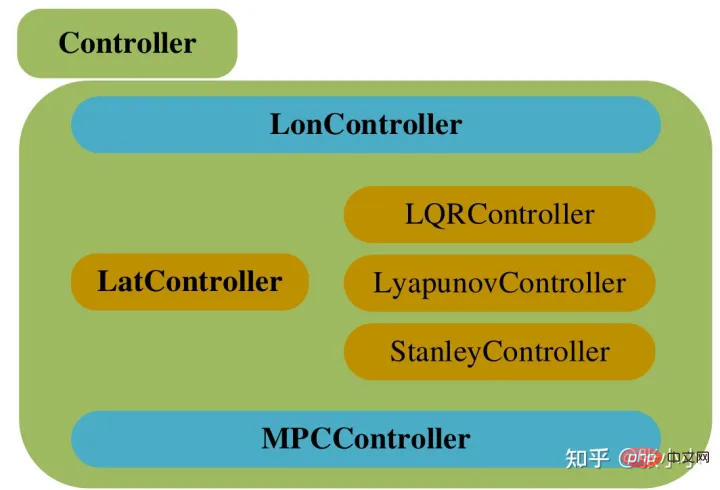
##The design of the controller is as shown in the figure above, where Controller As the base class, LonController, LonController and MPCController inherit this base class. LonController has derived subclasses such as LQRController, LyapunovController and StanleyController.
The above is the detailed content of Detailed explanation of commonly used control methods for smart car planning and control. For more information, please follow other related articles on the PHP Chinese website!

Hot AI Tools

Undresser.AI Undress
AI-powered app for creating realistic nude photos

AI Clothes Remover
Online AI tool for removing clothes from photos.

Undress AI Tool
Undress images for free

Clothoff.io
AI clothes remover

AI Hentai Generator
Generate AI Hentai for free.

Hot Article

Hot Tools

Notepad++7.3.1
Easy-to-use and free code editor

SublimeText3 Chinese version
Chinese version, very easy to use

Zend Studio 13.0.1
Powerful PHP integrated development environment

Dreamweaver CS6
Visual web development tools

SublimeText3 Mac version
God-level code editing software (SublimeText3)

Hot Topics
 1378
1378
 52
52
 The facial features are flying around, opening the mouth, staring, and raising eyebrows, AI can imitate them perfectly, making it impossible to prevent video scams
Dec 14, 2023 pm 11:30 PM
The facial features are flying around, opening the mouth, staring, and raising eyebrows, AI can imitate them perfectly, making it impossible to prevent video scams
Dec 14, 2023 pm 11:30 PM
With such a powerful AI imitation ability, it is really impossible to prevent it. It is completely impossible to prevent it. Has the development of AI reached this level now? Your front foot makes your facial features fly, and on your back foot, the exact same expression is reproduced. Staring, raising eyebrows, pouting, no matter how exaggerated the expression is, it is all imitated perfectly. Increase the difficulty, raise the eyebrows higher, open the eyes wider, and even the mouth shape is crooked, and the virtual character avatar can perfectly reproduce the expression. When you adjust the parameters on the left, the virtual avatar on the right will also change its movements accordingly to give a close-up of the mouth and eyes. The imitation cannot be said to be exactly the same, but the expression is exactly the same (far right). The research comes from institutions such as the Technical University of Munich, which proposes GaussianAvatars, which
 MotionLM: Language modeling technology for multi-agent motion prediction
Oct 13, 2023 pm 12:09 PM
MotionLM: Language modeling technology for multi-agent motion prediction
Oct 13, 2023 pm 12:09 PM
This article is reprinted with permission from the Autonomous Driving Heart public account. Please contact the source for reprinting. Original title: MotionLM: Multi-Agent Motion Forecasting as Language Modeling Paper link: https://arxiv.org/pdf/2309.16534.pdf Author affiliation: Waymo Conference: ICCV2023 Paper idea: For autonomous vehicle safety planning, reliably predict the future behavior of road agents is crucial. This study represents continuous trajectories as sequences of discrete motion tokens and treats multi-agent motion prediction as a language modeling task. The model we propose, MotionLM, has the following advantages: First
 Do you know that programmers will be in decline in a few years?
Nov 08, 2023 am 11:17 AM
Do you know that programmers will be in decline in a few years?
Nov 08, 2023 am 11:17 AM
"ComputerWorld" magazine once wrote an article saying that "programming will disappear by 1960" because IBM developed a new language FORTRAN, which allows engineers to write the mathematical formulas they need and then submit them. Give the computer a run, so programming ends. A few years later, we heard a new saying: any business person can use business terms to describe their problems and tell the computer what to do. Using this programming language called COBOL, companies no longer need programmers. . Later, it is said that IBM developed a new programming language called RPG that allows employees to fill in forms and generate reports, so most of the company's programming needs can be completed through it.
 GR-1 Fourier Intelligent Universal Humanoid Robot is about to start pre-sale!
Sep 27, 2023 pm 08:41 PM
GR-1 Fourier Intelligent Universal Humanoid Robot is about to start pre-sale!
Sep 27, 2023 pm 08:41 PM
The humanoid robot is 1.65 meters tall, weighs 55 kilograms, and has 44 degrees of freedom in its body. It can walk quickly, avoid obstacles quickly, climb steadily up and down slopes, and resist impact interference. You can now take it home! Fourier Intelligence's universal humanoid robot GR-1 has started pre-sale. Robot Lecture Hall Fourier Intelligence's Fourier GR-1 universal humanoid robot has now opened for pre-sale. GR-1 has a highly bionic trunk configuration and anthropomorphic motion control. The whole body has 44 degrees of freedom. It has the ability to walk, avoid obstacles, cross obstacles, go up and down slopes, resist interference, and adapt to different road surfaces. It is a general artificial intelligence system. Ideal carrier. Official website pre-sale page: www.fftai.cn/order#FourierGR-1# Fourier Intelligence needs to be rewritten.
 Huawei will launch the Xuanji sensing system in the field of smart wearables, which can assess the user's emotional state based on heart rate
Aug 29, 2024 pm 03:30 PM
Huawei will launch the Xuanji sensing system in the field of smart wearables, which can assess the user's emotional state based on heart rate
Aug 29, 2024 pm 03:30 PM
Recently, Huawei announced that it will launch a new smart wearable product equipped with Xuanji sensing system in September, which is expected to be Huawei's latest smart watch. This new product will integrate advanced emotional health monitoring functions. The Xuanji Perception System provides users with a comprehensive health assessment with its six characteristics - accuracy, comprehensiveness, speed, flexibility, openness and scalability. The system uses a super-sensing module and optimizes the multi-channel optical path architecture technology, which greatly improves the monitoring accuracy of basic indicators such as heart rate, blood oxygen and respiration rate. In addition, the Xuanji Sensing System has also expanded the research on emotional states based on heart rate data. It is not limited to physiological indicators, but can also evaluate the user's emotional state and stress level. It supports the monitoring of more than 60 sports health indicators, covering cardiovascular, respiratory, neurological, endocrine,
 What are the effective methods and common Base methods for pedestrian trajectory prediction? Top conference papers sharing!
Oct 17, 2023 am 11:13 AM
What are the effective methods and common Base methods for pedestrian trajectory prediction? Top conference papers sharing!
Oct 17, 2023 am 11:13 AM
Trajectory prediction has been gaining momentum in the past two years, but most of it focuses on the direction of vehicle trajectory prediction. Today, Autonomous Driving Heart will share with you the algorithm for pedestrian trajectory prediction on NeurIPS - SHENet. In restricted scenes, human movement patterns are usually To a certain extent, it conforms to limited rules. Based on this assumption, SHENet predicts a person's future trajectory by learning implicit scene rules. The article has been authorized to be original by Autonomous Driving Heart! The author's personal understanding is that currently predicting a person's future trajectory is still a challenging problem due to the randomness and subjectivity of human movement. However, human movement patterns in constrained scenes often vary due to scene constraints (such as floor plans, roads, and obstacles) and human-to-human or human-to-object interactivity.
 My smartwatch won't turn on: What to do now
Aug 23, 2023 pm 05:41 PM
My smartwatch won't turn on: What to do now
Aug 23, 2023 pm 05:41 PM
What to do if your smartwatch won't turn on? Here are the options available to restore the life of your beloved smartwatch. CHECK POWER PLAY: Imagine a star-studded stage with your smartwatch as the headliner, but the curtains don't rise because it forgot its battery! Before we delve into the details, make sure your smartwatch isn't just running on smoke and mirrors. Give it a proper charge time, and if you're feeling a little extra, give it a stylish new cable - the fashion-forward kind! Fantastic Reboot: When in doubt, give it a little R&R - that's Reboot and Revival! Press and hold these buttons like a maestro conducting a symphony. Different smartwatches have their own reboot rituals — Google is your guide. this is one
 UniOcc: Unifying vision-centric occupancy prediction with geometric and semantic rendering!
Sep 16, 2023 pm 08:29 PM
UniOcc: Unifying vision-centric occupancy prediction with geometric and semantic rendering!
Sep 16, 2023 pm 08:29 PM
Original title: UniOcc: UnifyingVision-Centric3DOccupancyPredictionwithGeometricandSemanticRendering Please click the following link to view the paper: https://arxiv.org/pdf/2306.09117.pdf Paper idea: In this technical report, we propose a solution called UniOCC, using For vision-centric 3D occupancy prediction trajectories in CVPR2023nuScenesOpenDatasetChallenge. Existing occupancy prediction methods mainly focus on using three-dimensional occupancy labels



